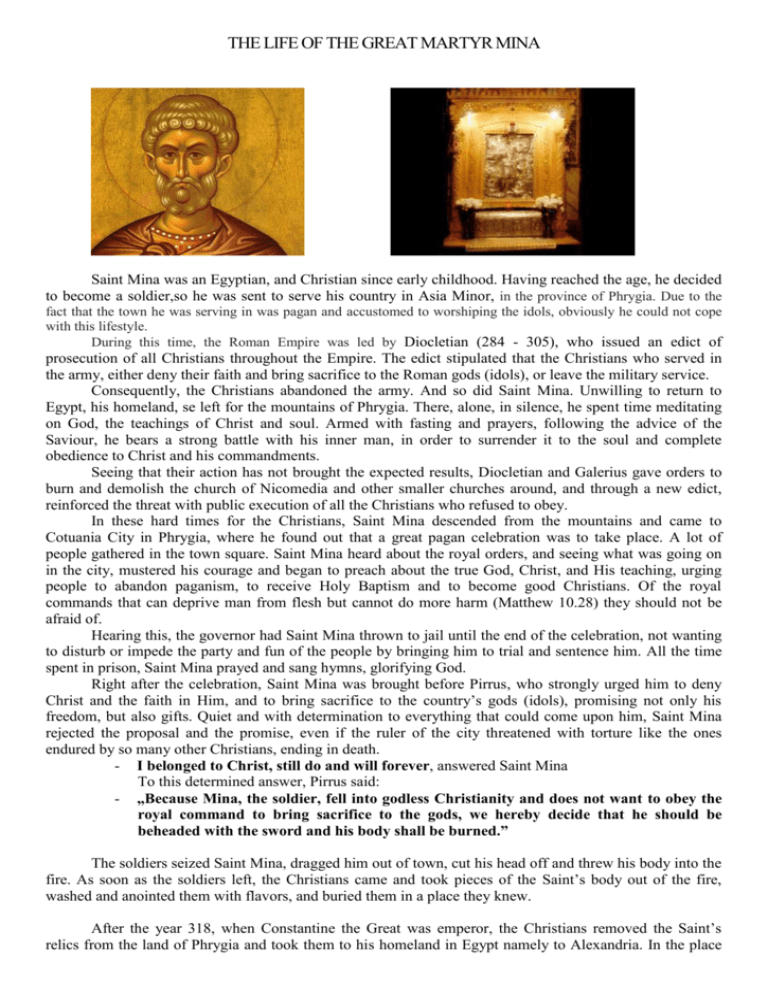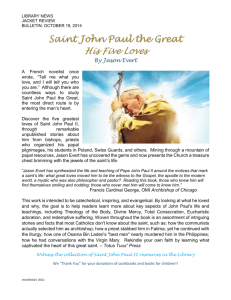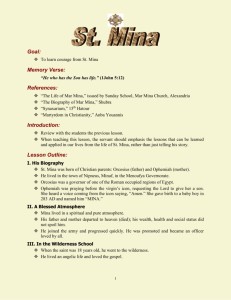THE LIFE OF THE GREAT MARTYR MINA Saint Mina was an Eg
advertisement

THE LIFE OF THE GREAT MARTYR MINA Saint Mina was an Egyptian, and Christian since early childhood. Having reached the age, he decided to become a soldier,so he was sent to serve his country in Asia Minor, in the province of Phrygia. Due to the fact that the town he was serving in was pagan and accustomed to worshiping the idols, obviously he could not cope with this lifestyle. During this time, the Roman Empire was led by Diocletian (284 - 305), who issued an edict of prosecution of all Christians throughout the Empire. The edict stipulated that the Christians who served in the army, either deny their faith and bring sacrifice to the Roman gods (idols), or leave the military service. Consequently, the Christians abandoned the army. And so did Saint Mina. Unwilling to return to Egypt, his homeland, se left for the mountains of Phrygia. There, alone, in silence, he spent time meditating on God, the teachings of Christ and soul. Armed with fasting and prayers, following the advice of the Saviour, he bears a strong battle with his inner man, in order to surrender it to the soul and complete obedience to Christ and his commandments. Seeing that their action has not brought the expected results, Diocletian and Galerius gave orders to burn and demolish the church of Nicomedia and other smaller churches around, and through a new edict, reinforced the threat with public execution of all the Christians who refused to obey. In these hard times for the Christians, Saint Mina descended from the mountains and came to Cotuania City in Phrygia, where he found out that a great pagan celebration was to take place. A lot of people gathered in the town square. Saint Mina heard about the royal orders, and seeing what was going on in the city, mustered his courage and began to preach about the true God, Christ, and His teaching, urging people to abandon paganism, to receive Holy Baptism and to become good Christians. Of the royal commands that can deprive man from flesh but cannot do more harm (Matthew 10.28) they should not be afraid of. Hearing this, the governor had Saint Mina thrown to jail until the end of the celebration, not wanting to disturb or impede the party and fun of the people by bringing him to trial and sentence him. All the time spent in prison, Saint Mina prayed and sang hymns, glorifying God. Right after the celebration, Saint Mina was brought before Pirrus, who strongly urged him to deny Christ and the faith in Him, and to bring sacrifice to the country’s gods (idols), promising not only his freedom, but also gifts. Quiet and with determination to everything that could come upon him, Saint Mina rejected the proposal and the promise, even if the ruler of the city threatened with torture like the ones endured by so many other Christians, ending in death. - I belonged to Christ, still do and will forever, answered Saint Mina To this determined answer, Pirrus said: - „Because Mina, the soldier, fell into godless Christianity and does not want to obey the royal command to bring sacrifice to the gods, we hereby decide that he should be beheaded with the sword and his body shall be burned.” The soldiers seized Saint Mina, dragged him out of town, cut his head off and threw his body into the fire. As soon as the soldiers left, the Christians came and took pieces of the Saint’s body out of the fire, washed and anointed them with flavors, and buried them in a place they knew. After the year 318, when Constantine the Great was emperor, the Christians removed the Saint’s relics from the land of Phrygia and took them to his homeland in Egypt namely to Alexandria. In the place where the relics were buried, a church was built in honor of Saint Mina. This church is known for the miraculous occurences of spontaneous healings, so people turned to it for help. Each year, on the 11th of November, the Orthodox Church honors the Holy Great Martyr Mina. Some of his relics are to be found in church „St. Mina-Vergului” in Bucharest. Wonderful discovery of the holy relics When the Lord wanted to reveal the place where the body of Saint Mina was buried, He resorted to the following way: there was a shepherd, who had a lamb suffering of scab; one day the lamb slipped into a fountain near the place where the relics of Saint Mina were buried. Coming out of the water, the lamb rolled into the sand and healed on the spot. Amazed, the shepherd began to mix the sand with water and anoint any suffering lamb with it. They healed immediately. The news spread quickly in the Byzantine Empire, and reached also the Emperor of Constantinople (apparently Saint Constantine itself), who had only one daugher suffering from leprosy. The king sent her to the place where the relics of Saint Mina were, to find out from the shepherd how the miracle worked. Following his instructions, the girl took sand, moistened it with water and rubbed it onto her body, then spent the night there. During her sleep, she saw Saint Mina who spoke to her: „Wake up early, dig in this place and you will find my body.” When she woke up, she was healed and, starting to dig, she found the body of the Saint. She quickly sent word to her father about what happened. The emperor rejoiced, thanking and praising God. As a sign of gratitude, the emperor offered financial support and sent out people to build a church in the honor of the glorious martyr Mina in that place. Later on, during the reign of the Roman emperors Arcadius and Honorius, it was decided that an impressive city should be built on that very spot, which was named Abu Mena (abu – father, holy). Bury-buried










